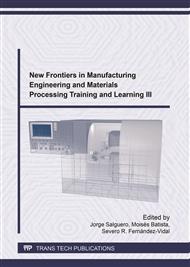[1]
Kalpakjian, S., Schmid, S. Manufacturing. Engineering and Technology. Pearson Higher Ed. Singapore, (2014).
Google Scholar
[2]
Sandvik Coromant. El mecanizado moderno. AB Sandvik Coromant Ed. Suecia, (1994).
Google Scholar
[3]
Groover, M.P. Fundamentals of Modern Manufacturing. Wiley Ed. United States, (2010).
Google Scholar
[4]
Lopez de Lacalle, L.N., Sánchez, J.A., Lamikiz, A. Mecanizado alto rendimiento. Ediciones Técnicas Izaro Ed. Vizcaya, (2004).
Google Scholar
[5]
ISO 3685: 1993. Tool-life testing with single-point turning tools, ISO (1993).
Google Scholar
[6]
Cao, Y., Kawara, Z., Yokomine, T., Kunugi, T. (2015). Visualization study on bubble dynamical behavior in subcooled flow boiling under various subcooling degree and flowrates. International Journal of Heat and Mass Transfer, 93, 839-852.
DOI: 10.1016/j.ijheatmasstransfer.2015.10.053
Google Scholar
[7]
Petukhov, V.A., Bublik, N.P., Gusev, P.A., Gutkin, L.D., Solntsev, O.I. Influence of the initiation energy on development of hydrogen-air mixtures combustion in large spherical volumes. High Temperature, 54 (1), (2016) 99-104.
DOI: 10.1134/s0018151x16010089
Google Scholar
[8]
Kostinskiy, A.Y., Syssoev, V.S., Mareev, E.A., Rakov, V.A., Andreev, M.G. (2015).
Google Scholar
[9]
Zhao, Z., Song, B., Yan, X., Yao, Q., Cao, X. (2015). Flow and Heat Transfer Characteristics of Two-Phase Fluid in Inclined Pipes on a Rotation Platform. Heat Transfer-Asian Research, 44 (8), (2015) 753-764.
DOI: 10.1002/htj.21151
Google Scholar
[10]
Medina Ríos, N. Caracterización Térmica del Proceso de Cilindrado Mediante Termografía Infrarroja y la Metodología de la Superficie de Respuesta Aplicado a Diversos Materiales. Caracterización del Tipo de Viruta Mediante Aplicación de Vídeo de Alta Velocidad. Trabajo Fin de Máster, Universidad de Castilla-La Mancha, Escuela de Ingenieros Industriales, Albacete, (2015).
DOI: 10.17660/ejhs.2021/86.1.6
Google Scholar
[11]
Rué, J. Enseñar en la Universidad: El EEES como reto para la Educación Superior. Narcea Ediciones. España, (2007).
Google Scholar
[12]
Comunicado de Bergen (2005). The European Higher Education Area. Achieving the goals, (2005).
Google Scholar
[13]
Bogumil, F.T., Abad, F. Mejoras del Aprendizaje y del Rendimiento de Grupos Reducidos de Estudiantes en una Asignatura de Proyectos de Ingeniería. Formación Universitaria, 1 (3), (2008) 13-20.
DOI: 10.4067/s0718-50062008000300003
Google Scholar


